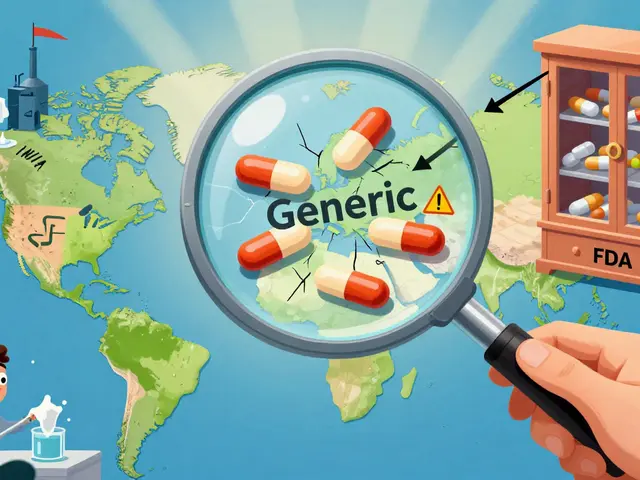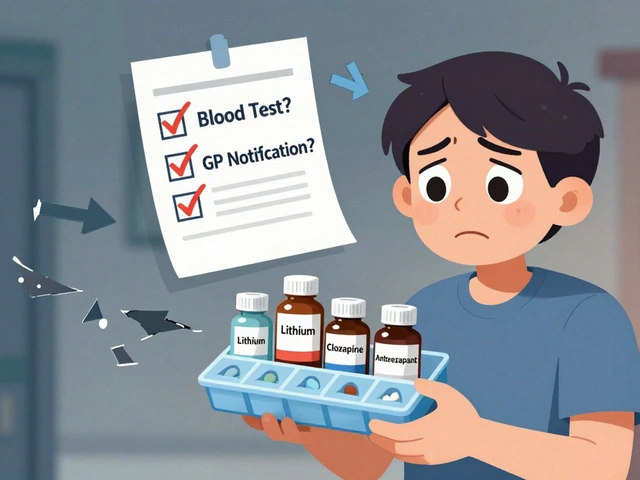Lopid (Gemfibrozil) vs. Common Alternatives: Pros, Cons, and How to Choose

Lipid Medication Selector
Use this tool to determine the most suitable lipid-lowering medication based on your lipid profile and clinical context.
TL;DR
- Gemfibrozil (Lopid) cuts triglycerides fast but can interact with statins.
- Fenofibrate offers similar triglyceride control with fewer muscle issues.
- Niacin raises HDL dramatically but often causes flushing.
- Statins are the go‑to for LDL reduction; they complement fibrates in high‑risk patients.
- Omega‑3s, bile‑acid sequestrants, PCSK9 inhibitors and ezetimibe fill niche gaps when other drugs aren’t tolerated.
What is Lopid (Gemfibrozil)?
Gemfibrozil is a fibric acid derivative that lowers triglycerides and modestly raises HDL cholesterol by activating peroxisome proliferator‑activated receptor‑α (PPARα). Approved by the FDA in 1976, it is marketed primarily under the brand name Lopid. Typical dosing is 1,200mg divided twice daily with meals. By turning on PPARα, Gemfibrozil increases the breakdown of very‑low‑density lipoprotein (VLDL) particles, cutting serum triglyceride levels up to 50% in many patients.
How Gemfibrozil Works - Mechanism at a Glance
The drug binds to nuclear PPARα receptors, which then switch on genes that code for lipoprotein lipase and other enzymes that clear triglyceride‑rich particles. This mechanism differentiates fibrates from statins, which inhibit HMG‑CoA reductase, the key step in cholesterol synthesis. Because Gemfibrozil does not touch the liver’s cholesterol‑making pathway, it leaves LDL unchanged or slightly reduced, while boosting the "good" HDL fraction.
When Doctors Choose Gemfibrozil
Gemfibrozil shines in patients with:
- Severe hypertriglyceridaemia (≥500mg/dL) that puts them at risk of pancreatitis.
- Mixed dyslipidaemia where both triglycerides and HDL need correction.
- Secondary prevention after a cardiovascular event where TG control adds benefit.
Key Alternatives to Gemfibrozil
Below are the most common drug classes that clinicians consider when Gemfibrozil isn’t suitable.
Fenofibrate is a fibric acid derivative similar to Gemfibrozil but with a longer half‑life and a lower propensity for drug‑drug interactions.
Niacin is a water‑soluble B‑vitamin that lowers triglycerides, reduces LDL, and raises HDL by inhibiting hepatic diacylglycerol acyltransferase.
Statins are a class of HMG‑CoA reductase inhibitors that primarily lower LDL cholesterol and modestly reduce triglycerides.
Omega‑3 fatty acids (eicosapentaenoic acid and docosahexaenoic acid) are prescription‑grade fish‑oil derivatives that lower triglycerides by reducing hepatic VLDL synthesis.
Bile‑acid sequestrants are non‑absorbable resins that bind bile acids in the intestine, forcing the liver to use more cholesterol to make new bile.
PCSK9 inhibitors are monoclonal antibodies that dramatically lower LDL by preventing the degradation of LDL receptors.
Ezetimibe is a cholesterol‑absorption inhibitor that blocks the Niemann‑Pick C1‑like 1 (NPC1L1) transporter in the gut.

Side‑Effect Profiles - What to Watch For
Every alternative comes with its own safety considerations. Understanding them helps avoid unpleasant surprises.
- Fenofibrate: mild renal impact; less muscle pain than Gemfibrozil; can raise liver enzymes.
- Niacin: intense flushing, hyperglycaemia, hepatotoxicity at high doses.
- Statins: myopathy, rare rhabdomyolysis, elevated liver enzymes; interactions with CYP3A4 drugs.
- Omega‑3 fatty acids: fishy aftertaste, GI upset, slight increase in LDL in some formulations.
- Bile‑acid sequestrants: constipation, bloating, can interfere with absorption of other oral meds.
- PCSK9 inhibitors: injection site reactions, modest flu‑like symptoms; high cost.
- Ezetimibe: mild GI disturbance, rare liver enzyme rise; generally well‑tolerated.
Head‑to‑Head Comparison
| Drug | Primary Mechanism | Key Lipid Effect | Typical Dose | Notable Side Effects |
|---|---|---|---|---|
| Gemfibrozil | PPARα agonist | ↓Triglycerides, ↑HDL | 1,200mg BID | Myopathy (with statins), gallstones |
| Fenofibrate | PPARα agonist | ↓Triglycerides, modest ↑HDL | 160mg daily | Renal impairment, ↑LFTs |
| Niacin | Inhibits hepatic diacylglycerol acyltransferase | ↑HDL, ↓Triglycerides, ↓LDL | 500mg-2g daily | Flushing, hyperglycaemia, hepatotoxicity |
| Statins (e.g., Atorvastatin) | HMG‑CoA reductase inhibition | ↓LDL, modest ↓Triglycerides | 10-80mg daily | Myopathy, ↑LFTs, drug interactions |
| Omega‑3 (EPA/DHA) | Reduces hepatic VLDL synthesis | ↓Triglycerides | 2-4g daily | Fishy aftertaste, GI upset |
| Bile‑acid sequestrants | Bind bile acids in gut | ↓LDL | 4-10g daily | Constipation, drug absorption interference |
| PCSK9 inhibitors | Prevent LDL‑R degradation | ↓LDL up to 60% | 140mg SC every 2weeks | Injection site reaction, cost |
| Ezetimibe | Inhibits NPC1L1 intestinal transporter | ↓LDL, modest ↓Triglycerides | 10mg daily | Mild GI symptoms |
Choosing the Right Therapy - A Practical Decision Tree
Start with the patient’s lipid pattern and risk profile, then walk through these checkpoints:
- If triglycerides are >500mg/dL and the goal is rapid reduction, Gemfibrozil or Fenofibrate are first‑line. Choose Fenofibrate when the patient is already on a statin.
- If HDL is extremely low (<35mg/dL) and the patient tolerates flushing, consider Niacin as an adjunct.
- When LDL is the primary target (<130mg/dL or higher) and cardiovascular risk is high, start with a Statin. Add a fibrate only if triglycerides remain elevated.
- For patients who cannot take statins (e.g., due to liver disease) and need LDL reduction, Ezetimibe or a PCSK9 inhibitor become viable.
- If cost is a major barrier and modest LDL lowering is acceptable, Bile‑acid sequestrants provide a cheap alternative, keeping in mind gastrointestinal side effects.
- When triglycerides sit between 200‑500mg/dL and the patient prefers a non‑tablet, prescribe high‑dose Omega‑3 fatty acids.
Always review drug‑interaction tables before stacking fibrates with statins; the safest combination is low‑dose statin+fenofibrate.
Related Concepts and How They Interact
The lipid‑management landscape is intertwined with several broader topics:
- Cardiovascular disease risk assessment - tools like QRISK3 guide when aggressive TG lowering is justified.
- Metabolic syndrome - insulin resistance often drives high TG; addressing lifestyle can reduce reliance on drugs.
- Genetic hypertriglyceridaemia - rare mutations may require combination therapy or newer agents like APOC3 inhibitors.
- Kidney function monitoring - fibrates are renally excreted; dose adjustments are needed in CKD.
- Drug‑food interactions - grapefruit juice boosts statin levels; high‑fat meals improve Gemfibrozil absorption.
Exploring these connections helps clinicians create a holistic plan rather than a pill‑popping checklist.
Frequently Asked Questions
Can I take Gemfibrozil and a statin together?
Combining Gemfibrozil with most statins (especially simvastatin or lovastatin) greatly raises the risk of muscle damage. If a combination is unavoidable, doctors usually switch to fenofibrate, which has a safer interaction profile.
Why does Gemfibrozil cause gallstones?
By increasing the breakdown of triglycerides, the drug also alters bile composition, making cholesterol crystals more likely to form. Patients with a history of gallbladder disease should discuss alternatives with their clinician.
Is fenofibrate as effective as Gemfibrozil?
Clinical trials show fenofibrate reduces triglycerides by a similar magnitude (≈45‑55%) and raises HDL slightly less than Gemfibrozil, but with fewer muscle‑related side effects. It is often the preferred fibrate when a patient is already on a statin.
When should I consider an omega‑3 prescription?
If fasting triglycerides stay between 200‑500mg/dL after dietary changes, a high‑dose EPA/DHA product can shave 30‑50% off the level. It’s especially useful for patients who cannot tolerate fibrates.
Are PCSK9 inhibitors ever combined with fibrates?
Yes, in high‑risk individuals who need aggressive LDL lowering (via PCSK9 inhibitors) *and* still have high triglycerides, a low‑dose fibrate can be added. Monitoring liver and kidney function is essential.
18 Comments
Alex Bennett
Ah, the age‑old dilemma of choosing a fibrate over a statin-because apparently we love paperwork as much as we love lower triglycerides. In reality, Gemfibrozil shines when you need a quick drop in very high TG levels, especially above 500 mg/dL, but beware of its notorious interaction with statins. If you’re already on a statin, fenofibrate tends to be the safer side‑kick, sparing you from nasty muscle aches. Of course, your individual risk profile and liver function should still dictate the final pick.
Mica Massenburg
What they don’t tell you is that big pharma pushes Gemfibrozil as a “quick fix” while quietly funding the studies that downplay its side‑effects. The hidden agenda is to keep you on multiple drugs forever, ensuring a steady stream of prescriptions. Keep an eye on the fine print and ask your doctor why they’re favoring a drug that’s been around since the ’70s.
Sarah Brown
Let’s break it down: if your triglycerides are soaring above 500 mg/dL, Gemfibrozil can be a lifesaver, but you’ll want to monitor liver enzymes closely. For patients already on statins, fenofibrate often provides similar triglyceride reduction with fewer drug‑drug interactions. Remember to consider lifestyle changes-diet, exercise, weight loss-because medication alone rarely solves the whole picture. Empower yourself with knowledge and work with your clinician to tailor the regimen.
Max Canning
Yo, if your TGs are through the roof, don’t waste time-Gemfibrozil drops them fast. But if you’re already on a statin, swap to fenofibrate to dodge the muscle pain drama. Keep the diet clean, stay active, and let the meds do the heavy lifting.
Nick Rogers
Indeed, Gemfibrozil offers rapid triglyceride reduction; however, clinicians should assess hepatic function regularly; fenofibrate may be preferable when a patient is concurrently on a statin; lifestyle modification remains essential; monitoring for myopathy is advised.
Tesia Hardy
Totally agree with the need for regular check‑ups-sometimes I forget my labs too! Just a quick reminder: staying hydrated can actually help your liver handle these meds better, so sip that water. And don’t be hard on yourself if you miss a dose; just get back on track and keep moving forward.
Matt Quirie
When evaluating Gemfibrozil versus alternative agents, it is prudent to consider both efficacy and safety profiles. The drug’s ability to lower triglycerides by up to 50 % in severe hypertriglyceridaemia is well documented; however, its interaction with statins may precipitate rhabdomyolysis. Consequently, a thorough medication reconciliation should precede initiation. Moreover, patient education regarding potential side‑effects is indispensable.
Pat Davis
From a broader perspective, we must also acknowledge the socioeconomic factors influencing drug choice. In many regions, fenofibrate is more affordable and thus more accessible to patients who cannot bear the cost of Gemfibrozil. Ensuring equitable access to effective lipid‑lowering therapy should be a priority for healthcare systems worldwide.
Mary Wrobel
Picture this: your liver is a bustling kitchen, and Gemfibrozil is the sous‑chef that whisks away excess triglyceride “ingredients.” It works wonders when the kitchen is overloaded, but you don’t want it clashing with the head chef-your statin. A well‑balanced menu of whole foods, good fats, and regular movement can keep the kitchen running smoothly, letting the meds do their part without burning anything.
Neeraj Agarwal
Actually, it’s “triglycerides,” not “triglyceride.” Also, the phrase “whisks away excess triglyceride ‘ingredients’” sounds a bit forced; you could simply say “removes excess triglycerides.” Minor nitpicks, but the overall point stands.
Rose K. Young
Ugh, another “deep dive” that basically rehashes what the label already says. If you’re looking for groundbreaking insight, you won’t find it here-just the same old pros and cons list. Honestly, I’d rather read a novel than slog through another generic lipid comparison.
Christy Pogue
Hey everyone, don’t let the jargon scare you! Whether you pick Gemfibrozil or fenofibrate, the key is consistency and pairing the med with a heart‑healthy lifestyle. Celebrate the small victories-like a lower TG reading after a week of smart meals-and keep the momentum going! 🎉 (Oops, I know emojis are a no‑go, but the excitement is real.)
Helena Pearson
When we gaze into the swirling sea of triglycerides, we are reminded that the body is a symphony of chemistry, each note resonating with our choices and genetics. Gemfibrozil, the seasoned veteran of the fibrate class, steps onto this stage with a powerful crescendo, slashing triglyceride levels when they threaten to surge beyond 500 mg/dL. Yet, like any bold soloist, it can clash with the familiar statin melody, risking discordant muscle pain if not carefully orchestrated. Fenofibrate, the younger sibling, offers a gentler harmony, often sidestepping the myopathic pitfalls while still delivering a respectable drop in lipid excess. The decision, therefore, is less about picking a “winner” and more about tuning the entire ensemble-diet, exercise, and medication-to play in unison. 🍏🥦🥑
Consider the patient who, after a weekend of indulgent feasting, watches their labs balloon. A short‑term burst of Gemfibrozil can be the emergency brake, rapidly pulling those numbers down before the danger of pancreatitis looms. However, for the chronic composer who already enjoys a statin’s LDL‑lowering lullaby, fenofibrate becomes the logical counterpoint, preserving the rhythm without inviting the dreaded muscle soreness. Moreover, the liver, that unsung steward of metabolism, demands our respect; regular monitoring of transaminases is non‑negotiable regardless of the chosen agent.
Beyond the biochemistry, we must honor the psychosocial beats-the anxiety of taking another pill, the financial cadence of prescription costs, and the cultural narratives that shape how we perceive “medicine.” A collaborative conversation with the clinician, where the patient’s voice rings as loud as the lab values, transforms the prescription from a command into a shared journey. In this partnership, lifestyle interventions-like swapping fried foods for omega‑3‑rich fish, strolling after dinner, and prioritizing sleep-act as the steady percussion that supports any pharmacologic lead.
Ultimately, whether Gemfibrozil or fenofibrate takes center stage, the true masterpiece is the patient’s holistic wellbeing. Embrace the data, listen to your body, and let the roadmap guide you toward a heart that beats confidently, free from the turbulence of unchecked triglycerides.
Patricia Fallbeck
Ah, the usual hymn to “holistic wellbeing”-how quaint. While everyone gushes about the symphonic metaphor, the stark reality is that Gemfibrozil’s bitter aftertaste in the clinical world is its propensity for gallstone formation, a fact the poetic narratives conveniently gloss over. Fenofibrate, praised for its “gentle harmony,” actually harbors a less‑celebrated risk of renal impairment in susceptible individuals. So before we drown in rose‑colored prose, let’s acknowledge that sometimes the simplest, most austere solution-dietary overhaul without any pill-outperforms the pharmacologic fanfare. 🎭
Brett Snyder
Look, the American healthcare system loves pushing brand‑name drugs like Gemfibrozil for profit. If you want real results, ask why the government doesn’t push fenofibrate harder-maybe because it’s cheaper and keeps the pharma money flowing elsewhere.
Nidhi Jaiswal
While the criticism has some truth, it’s important to note that both drugs have specific indications. Gemfibrozil is effective for severe hypertriglyceridaemia, and fenofibrate works well for moderate cases. Decision should be based on patient profile, not politics.
Sunil Sharma
Hey folks, just a quick heads‑up: when you start on any fibrate, make sure your doctor checks your kidney function at baseline and after a few months. It helps catch any early changes before they become a problem.
Leah Robinson
Thanks for the reminder, Sunil! 🙌 I always set a calendar alert for my labs so I don’t miss them. Staying on top of the numbers makes the whole process less stressful.






Write a comment